Themed collection FOCUS: Recent Advance in Supercapacitors

Research progress of MXenes and layered double hydroxides for supercapacitors
In this study, the preparation methods of MXenes and layered dihydroxides (LDHs) are reviewed. In addition, the preparation and the electrochemical performances for supercapacitors of MXene/LDHs composites are summarized in detail.

Inorg. Chem. Front., 2023,10, 4358-4392
https://doi.org/10.1039/D3QI00819C
Progress of layered double hydroxide-based materials for supercapacitors
The methods for the preparation and modification of layered double hydroxides (LDHs) in recent years are reviewed in this paper. In addition, their electrochemical properties and applications in the field of supercapacitors are demonstrated.

Mater. Chem. Front., 2023,7, 1520-1561
https://doi.org/10.1039/D2QM01346K
Emergent pseudocapacitive behavior of single-walled carbon nanotube hybrids: a materials perspective
Supercapacitor technology encompasses a wide field of research that has already marked its foot in commercialization, just after some initial years of concept development.
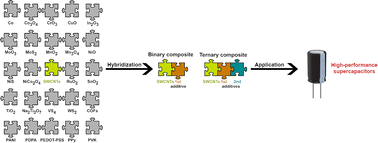
Mater. Chem. Front., 2022,6, 2386-2412
https://doi.org/10.1039/D2QM00146B
Interlayer ionic diffusion driven in situ QD-deposition in the Co9S8–LDH hybrid supercapacitor electrode
QDs-Co9S8/CoNi-LDH was assembled by selective sulfurization derived from 2D MOF with the loading of Co9S8 quantum dots into layered double hydroxides. The constructed hybrid supercapacitor shown energy density of 33.3 Wh kg−1 at 820.0 W kg−1.

Mater. Chem. Front., 2024,8, 3280-3289
https://doi.org/10.1039/D4QM00462K
Highly efficient utilization of polypyrrole enabled by dispersed buckypaper tape for high-performance flexible energy storage
This work develops a facile anodic treatment process to prepare dispersed buckypaper tape for the highly efficient utilization of polypyrrole towards durable flexible energy storage.

Inorg. Chem. Front., 2024,11, 6616-6626
https://doi.org/10.1039/D4QI01579G
A surface defect strategy of NiCo-layered double hydroxide decorated MXene layers for durable solid-state supercapacitors
The aggregation and self-stacking of MXenes and layered double hydroxides (LDHs) in the electrode preparation process are considered the primary obstacles to their practical applications.

Mater. Chem. Front., 2024,8, 3231-3241
https://doi.org/10.1039/D4QM00481G
Solvent-free, deep eutectic system-assisted synthesis of nanoarchitectonics of hierarchical porous carbons for high rate supercapacitors
Solvent-free, deep eutectic system-assisted synthesis of hierarchical porous carbons for high rate and high energy density supercapacitors.

Mater. Chem. Front., 2024,8, 3157-3165
https://doi.org/10.1039/D4QM00489B
Effects of Fe-doping induced by valence modulation engineering on the nickel hydroxyfluoride cathode of hybrid supercapacitors
Fe doping promotes the formation of high valence Ni(3+δ)+, promoting the two-step reaction that improves energy storage.

Inorg. Chem. Front., 2024,11, 5674-5684
https://doi.org/10.1039/D4QI01393J
Optimizing the quantum capacitance of AsXBr/AsYBr ((X ≠ Y) = S, Se and Te) Janus heterostructures for high-performance supercapacitors
Tailoring the characteristics of AsXBr/AsYBr ((X ≠ Y) = S, Se and Te) Janus heterostructures for advanced supercapacitor applications.

Mater. Chem. Front., 2024,8, 2775-2787
https://doi.org/10.1039/D4QM00345D
Designing CoS2-Mo2C and CoS2-W2C hybrids for high-performance supercapacitors and hydrogen evolution reactions
A hydrothermal reaction was employed to design CoS2-based metal carbide hybrids. The assembled device offered 423 F g−1 capacitance and 150 W h kg−1 energy density along with a notable HER performance under acidic and KOH media for CoS2-W2C.

Inorg. Chem. Front., 2024,11, 4001-4018
https://doi.org/10.1039/D4QI00759J
Electrochemically triggered rational design of bismuth copper sulfide for wearable all-sulfide semi-solid-state supercapacitor with a wide operational potential window (1.8 V) and ultra-long life
Gel electrolyte-based wearable all-sulfide semi-solid-state supercapacitor (ASSSC) device with ∼100% capacitance retention across the 40 000 charge–discharge cycles. The ASSSC devices are attached to human fingers to power electronic gadgets.

Inorg. Chem. Front., 2024,11, 3270-3284
https://doi.org/10.1039/D4QI00675E
Nanosheet floral clusters of Fe-doped Co3O4 for high-performance supercapacitors
A straightforward hydrothermal process followed by thermal treatment is developed for constructing Fe-doped Co3O4 nanosheet floral clusters, which exhibit excellent electrochemical performance as supercapacitor electrodes.

Mater. Chem. Front., 2024,8, 2282-2292
https://doi.org/10.1039/D4QM00170B
Iron-doped nickel sulfide nanospheres anchored on reduced graphene oxide for high performance supercapacitors
Fe doping in the NiS lattice leads to an increase in the density of states near the Fermi level and thus to improved charge storage.

Mater. Chem. Front., 2024,8, 1816-1826
https://doi.org/10.1039/D3QM01335A
Acetate ion-intercalated NiCo-LDH with quasi-theoretical capacitance for high energy/power density aqueous supercapacitors
One-step solvothermal method is used to produce Ni0.7Co0.3-LDH intercalated with acetate. The incorporation of Co and acetate regulates pore size distribution and heterogeneous electron configuration, facilitating ion diffusion and redox activity.

Inorg. Chem. Front., 2024,11, 863-873
https://doi.org/10.1039/D3QI02264A
“All-in-one” polypyrrole pillar hybridization flexible membranes on multimodal tactile sensors for wearable energy-storage devices and human–machine interfaces
We designed an “all-in-one” polypyrrole pillar hybridization flexible membrane for wearable energy-storage devices and human–machine interfaces (HMIs).

Inorg. Chem. Front., 2024,11, 936-946
https://doi.org/10.1039/D3QI02119J
Carbon quantum dot regulated electrochemical activation of Co0.03Ni0.97LDH for energy storage
The valence and coordination structure of transition metals in electrode materials play a crucial role in the electrochemical energy storage process.

Inorg. Chem. Front., 2024,11, 899-911
https://doi.org/10.1039/D3QI02027D
In situ construction of core–shell structured cobalt oxide@nickel–cobalt-layered double hydroxide nanorods with abundant oxygen vacancies towards boosting electrochemical energy storage
A facile in situ “growth–conversion–oxidation” strategy is employed to fabricate a core–shell structured CoO@Ov-NiCo LDH with abundant oxygen vacancies, which significantly improves the electrochemical performance.

Inorg. Chem. Front., 2024,11, 789-798
https://doi.org/10.1039/D3QI02214E
Porous graphene/CNT@metal (hydr)oxide composite films achieving fast ion and electron kinetics for asymmetric supercapacitors with ultra-high volumetric performance
A material structure design with 3D fast ion and electron diffusion channels for flexible supercapacitors with a high volumetric energy density.

Inorg. Chem. Front., 2024,11, 632-645
https://doi.org/10.1039/D3QI01792C
Electric field-induced ball-cactus-like CuCo2Sx(OH)y nano-heterostructure towards high-performance supercapacitors
Herein, a simple electric field-induced anion exchange process was raised to prepare a novel nanostructured CuCo2Sx(OH)y heterostructure based on CuCo2S4 nanosheets as a substrate.

Inorg. Chem. Front., 2023,10, 6369-6383
https://doi.org/10.1039/D3QI01277H
Oxygen vacancies meet partial S substitution: an effective strategy to achieve obvious synergistic effects and adjustable electrochemical behavior in NiFe-LDH for enhanced OER and capacitive performance
Attributed to the strong synergy between S and oxygen vacancies, as well as the adjustable electrochemical behavior, the prepared bifunctional electrode exhibited superior OER and capacitive performance.

Inorg. Chem. Front., 2023,10, 5391-5405
https://doi.org/10.1039/D3QI01131C
Compatible and high-efficiency quasi-solid-state integrated photocapacitor based on the synergism of PEDOT/RGO electrode and gel electrolyte to improve the carrier migration
A novel quasi-solid-state integrated photo-capacitor (IPC) with flexible PEDOT/RGO film as a common electrode will improve carrier migration and the excellent overall conversion efficiency (arrive at 5.8%) of IPC.

Inorg. Chem. Front., 2023,10, 4993-5003
https://doi.org/10.1039/D3QI00332A
Engineering raspberry-like CuCo2S4@ZnS hollow particles encapsulated with reduced graphene oxide for hybrid supercapacitors
Raspberry-like CuCo2S4@ZnS hollow particles encapsulated with reduced graphene oxide are synthesized for hybrid supercapacitors.

Mater. Chem. Front., 2023,7, 3127-3145
https://doi.org/10.1039/D3QM00212H
Solid-state supercapacitors based on polyoxometalate-based crystalline materials modified with polyaniline
The conductive polymer PANI was coated on the surface of POM-based electrodes by the method of electrodeposition for improving the capacitive performance, and the corresponding solid-state SCs exhibited excellent capacitive performance.

Inorg. Chem. Front., 2023,10, 3641-3647
https://doi.org/10.1039/D3QI00451A
Boosting the crystallinity of novel two-dimensional hexamine dipyrazino quinoxaline-based covalent organic frameworks for electrical double-layer supercapacitors
A novel and conjugated 2D 250-HADQ COF exhibits a high specific surface area and excellent thermal stability yielding high values of gravimetric capacitance and energy density in two-electrode double-layer supercapacitor cells.

Mater. Chem. Front., 2023,7, 2464-2474
https://doi.org/10.1039/D3QM00169E
A hollow urchin-like metal–organic framework with Ni–O-cluster SBUs as a promising electrode for an alkaline battery–supercapacitor device
A hollow NiPSC electrode with a large d-spacing lattice distance has been demonstrated as an active SC electrode in a supercapacitor–battery hybrid device to achieve superior electrochemical performance.

Inorg. Chem. Front., 2023,10, 2380-2386
https://doi.org/10.1039/D3QI00123G
Rational construction of porous marigold flower-like nickel molybdenum phosphates via ion exchange for high-performance long-lasting hybrid supercapacitors
The assembled hybrid supercapacitor device using the urea-based nickel molybdenum phosphate nanopetals embedded microspheres electrode exhibits outstanding long-term cycling stability, demonstrating its practical applications.

Inorg. Chem. Front., 2023,10, 2075-2087
https://doi.org/10.1039/D2QI02697J
NiCo layered double hydroxide nanocages for high-performance asymmetric supercapacitors
NiCo-LDH nanocages with high specific capacity, energy densities and good capacity retention are prepared with a Cu2O template etching method.

Inorg. Chem. Front., 2023,10, 2154-2164
https://doi.org/10.1039/D2QI02763A
A UiO-66-NH2 MOF derived N doped porous carbon and ZrO2 composite cathode for zinc-ion hybrid supercapacitors
The N doped porous carbon and ZrO2 composite (NC@ZrO2) with a synergistic pseudocapacitive effect provides abundant active sites for zinc ions and favors fast ion diffusion, ensuring remarkable rate performance and long cycling stability.

Inorg. Chem. Front., 2023,10, 2115-2124
https://doi.org/10.1039/D2QI02777A
Morphology-controllable bimetallic MOFs/textile composite electrodes with high areal capacitance for flexible electronic devices
A new strategy has been designed for enhancing the electrochemical performances of supercapacitor electrodes.

Mater. Chem. Front., 2023,7, 1411-1422
https://doi.org/10.1039/D2QM00126H
Co-doped MnO2 with abundant oxygen vacancies as a cathode for superior aqueous magnesium ion storage
Co-doped manganese dioxide was fabricated for an aqueous magnesium ion hybrid supercapacitor, showing excellent energy density and long-term cycle life.
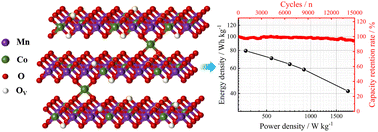
Inorg. Chem. Front., 2023,10, 1748-1757
https://doi.org/10.1039/D2QI02380F
Compositing redox-rich Co–Co@Ni–Fe PBA nanocubes into cauliflower-like conducting polypyrrole as an electrode material in supercapacitors
Supercapacitors (SCs) coupled with redox materials have been extensively investigated to maximize the energy density of SCs.

Mater. Chem. Front., 2023,7, 1110-1119
https://doi.org/10.1039/D2QM01162J
Hydrogen bond stabilized β-Ni(OH)x–SO4 interlaminar materials for highly active supercapacitors
Porous β-Ni(OH)x–SO4 interlaminar material has been prepared with an expanded interplane spacing and in-plane porous channels, which exhibits advanced supercapacitor property with a high specific capacity of 212.5 mA h g−1 at 3 A g−1.
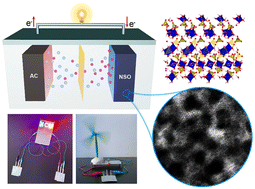
Inorg. Chem. Front., 2023,10, 1001-1010
https://doi.org/10.1039/D2QI01992B
Phosphate functionalized CoS nanoparticles coupled with Fe2O3 nanocrystals decorated on N,S co-doped porous carbon spheres for advanced hybrid supercapacitors
An advanced hybrid supercapacitor with excellent electrochemical features was assembled using N,S co-doped porous carbon sphere decorated CoS nanoparticles with phosphate functionalization and ultrafine Fe2O3 nanocrystals.

Inorg. Chem. Front., 2023,10, 406-416
https://doi.org/10.1039/D2QI02003C
The synthesis of zeolitic imidazolate framework/prussian blue analogue heterostructure composites and their application in supercapacitors
ZIF-67/PBA heterostructure composites was prepared by the ion-exchange method with ZIF-67 nanoparticles as host MOFs. The electrochemical performance of the ZIF-67/PBA heterostructure composites improved after low-temperature calcination.

Inorg. Chem. Front., 2023,10, 78-84
https://doi.org/10.1039/D2QI01966C
pH-controlled assembling of POM-based metal–organic frameworks for use as supercapacitors and efficient oxidation catalysts for various sulfides
Two 3D POM-based metal–organic frameworks were prepared, which can be applied as electrode materials for supercapacitors, as well as efficient heterogeneous catalysts for the selective oxidation of sulfides to their corresponding sulfoxides.

Inorg. Chem. Front., 2023,10, 148-157
https://doi.org/10.1039/D2QI01922A
Novel core–shell nanoclusters composed of multiple nickel–cobalt-oxyselenide nanowires wrapped with NiCo-LDH nanosheets for high energy density supercapacitors
A novel core–shell nanocluster NCOSe/Ni2Co1-LDH was constructed with excellent electrochemical properties. Moreover, the assembled HSC achieves an extremely high energy density of 89.7 Wh kg−1 at a power density of 800 W kg−1.

Inorg. Chem. Front., 2023,10, 192-200
https://doi.org/10.1039/D2QI01739C
High performance supercapacitors based on wood-derived thick carbon electrodes synthesized via green activation process
A green, versatile, and universal H2O2 activation method is proposed to improve the capacitive properties of high-mass loading wood-based supercapacitors.

Inorg. Chem. Front., 2022,9, 6108-6123
https://doi.org/10.1039/D2QI01914K
Bimetallic electronic effects of Mn-doped Ni-MOF shuttle-like nanosheets remarkably enhance the supercapacitive performance
We explored a new class of binder-free Mn doped Ni-based MOFs nanosheets through a polarity-induced solution-phase method for HSCs. The relationship between the electronic structure and the electrochemical activity has been further identified.

Inorg. Chem. Front., 2022,9, 5982-5993
https://doi.org/10.1039/D2QI01700H
Compositing MXenes with hierarchical ZIF-67/cobalt hydroxide via controllable in situ etching for a high-performance supercapacitor
The accumulation and self-aggregation of nanosheets have been effectively inhibited. The interlamellar cobalt hydroxide nanostructures ensure efficient electron transfer. MXene as a conductive substrate improves electron transfer significantly.

Inorg. Chem. Front., 2022,9, 5463-5468
https://doi.org/10.1039/D2QI01641A
Solution-processable hierarchical SiNW/PEDOT/MnOx electrodes for high-performance supercapacitors
Hierarchical core–shell electrode of PEDOT and MnOx decorated SiNWs was developed through a simple, facile and low-temperature method, which displayed an excellent areal capacitance of 352.08 mF cm−2.

Mater. Chem. Front., 2022,6, 2894-2904
https://doi.org/10.1039/D2QM00544A
A VO3−-induced S2−-exchange strategy to controllably construct a sub-nano-sulfide-functionalized layered double hydroxide for an enhanced supercapacitor performance
(Ni/Co)1−xS sub-nanoparticle-functionalized Co/Ni-LDH hollow nanocages (S-CNV-LDH) are prepared using a VO3−-induced S2−-exchange strategy, which presents an enhanced supercapacitor performance.

Mater. Chem. Front., 2022,6, 2661-2669
https://doi.org/10.1039/D2QM00503D
Fabrication of dual-functional electrodes using oxygen vacancy abundant NiCo2O4 nanosheets for advanced hybrid supercapacitors and Zn-ion batteries
V-ZnCo2O4/Ni composites with rich oxygen vacancies are designed through a hydrothermal method followed by post calcination and reduction. This strategy enhanced electrical conductivity, modulated electronic structure, and increased active sites.

Inorg. Chem. Front., 2022,9, 4452-4463
https://doi.org/10.1039/D2QI00739H
Petal-like and cube-like manganese silicates derived from natural reed leaves for high-performance supercapacitors
N, P, S-Doped petal-like and cube-like C–(Mn2O3)3MnSiO3 are derived from reed leaves and used in supercapacitors.

Mater. Chem. Front., 2022,6, 2447-2457
https://doi.org/10.1039/D2QM00376G
Bifunctional NiFe LDH as a piezoelectric nanogenerator and asymmetric pseudo-supercapacitor
Lead-free nickel–iron layered-double hydroxide (NiFe LDH) nanomaterial is used to fabricate a self-powered unit based on a piezoelectric nanogenerator and high-performance asymmetric supercapacitor (ASC).

Mater. Chem. Front., 2022,6, 2297-2308
https://doi.org/10.1039/D2QM00275B
Growing Co–Ni–Se nanosheets on 3D carbon frameworks as advanced dual functional electrodes for supercapacitors and sodium ion batteries
The reasonable design of electrode materials is crucial for tuning the electrochemical performances of advanced energy storage systems.

Inorg. Chem. Front., 2022,9, 3933-3942
https://doi.org/10.1039/D2QI00695B
Hierarchical Ni(OH)2–MnO2 hollow spheres as an electrode material for high-performance supercapacitors
Hierarchical Ni(OH)2–MnO2 hollow spheres are prepared via a simple self-templating route. The structural and compositional advantages of the Ni(OH)2–MnO2 material endow it with remarkable performance as a supercapacitor.

Inorg. Chem. Front., 2022,9, 3542-3551
https://doi.org/10.1039/D2QI00780K
Two-in-one template-assisted construction of hollow phosphide nanotubes for electrochemical energy storage
Nickel-based phosphide hollow nanotubes were constructed using a template strategy. The introduction of PANI may lead to the formation of C–Ni bonds or C–Ni–P bonds at the electrode interface, which induces electron transfer and improves the electrochemical capacity.
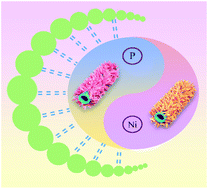
Inorg. Chem. Front., 2022,9, 3398-3411
https://doi.org/10.1039/D2QI00366J
A sequential process to synthesize Fe3O4@MnO2 hollow nanospheres for high performance supercapacitors
A hybrid consisting of Fe3O4 and MnO2 with hollow structures was synthesized, and was demonstrated to be an efficient electrode for supercapacitors.

Mater. Chem. Front., 2022,6, 1938-1947
https://doi.org/10.1039/D2QM00450J
Controlled synthesis of a cobalt-organic framework: hierarchical micro/nanospheres for high-performance supercapacitors
We report a strategy to synthesize Co-MOF-based hierarchical micro/nanospheres with ultrathin nanosheet subunits. Benefitting from the unique 3D architecture, the Co-MOF/M2 exhibits a high specific capacitance and excellent rate capability.
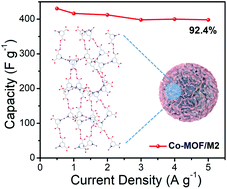
Inorg. Chem. Front., 2022,9, 2845-2851
https://doi.org/10.1039/D2QI00453D
Green synthesis of N-doped porous carbon/carbon dot composites as metal-free catalytic electrode materials for iodide-mediated quasi-solid flexible supercapacitors
The synthesis procedure of the N-doped PC-CDs composite and the electrochemical reaction of iodide at the PC-CDs surface.

Inorg. Chem. Front., 2022,9, 2530-2543
https://doi.org/10.1039/D2QI00017B
Mechanically exfoliated graphite paper with layered microstructures for enhancing flexible electrochemical energy storage
This work fabricates mechanically exfoliated graphite paper with layered microstructures, which not only ensures the high flexibility of the resulting electrochemical capacitor, but substantially boosts its electrochemical properties.

Inorg. Chem. Front., 2022,9, 1920-1930
https://doi.org/10.1039/D1QI01601F
MoS2 nanosheets with expanded interlayer spacing for ultra-stable aqueous Mg-ion hybrid supercapacitor
Magnesium ion supercapacitor assembled by MoS2 with expanded layer spacing as the anode displays larger capacitance and excellent long-term cycling stability.
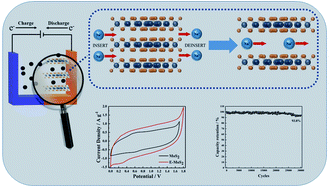
Inorg. Chem. Front., 2022,9, 1666-1673
https://doi.org/10.1039/D1QI01613J
Ionic liquid surfactant-derived carbon micro/nanostructures toward application of supercapacitors
Microequilibrium transformation of micelles and vesicles assembled by ionic liquid surfactants enables the precise structural design and controlled synthesis of carbon micro/nanospheres, which can be used for high-performance supercapacitor electrodes.

Inorg. Chem. Front., 2022,9, 1609-1621
https://doi.org/10.1039/D1QI01570B
Design of NiCo2O4@NiMoO4 core–shell nanoarrays on nickel foam to explore the application in both energy storage and electrocatalysis
NiCo2O4@NiMoO4 core–shell nanowires (NCNMW) and nanosheets (NCNMS) with high electrochemical capabilities were synthesized using a simple two-step hydrothermal reaction, together with a calcination process.

Mater. Chem. Front., 2022,6, 1056-1067
https://doi.org/10.1039/D1QM01534F
Preparation of nickel-bound porous carbon and its application in supercapacitors
In this study, nickel-bound porous carbon (Ni-PC) was prepared by introducing Ni2+ into dipotassium ethylenediaminetetraacetate (EDTA-2K) derived nitrogen-doped porous carbon (PC) using the ball milling method.

Inorg. Chem. Front., 2022,9, 652-661
https://doi.org/10.1039/D1QI01403J